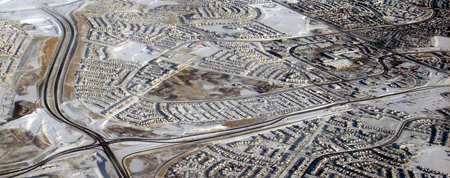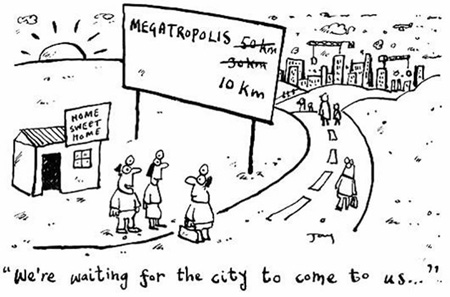Suburbanisation means that the urban ring grows at the cost of the urban core. The cities are growing in their surroundings, the contemporary city is surrounded by increasingly extensive residential suburbs (Bronger 2004, Pacione 2001, Renwick, Rubenstein 1995).
"People have migrated to the periphery of the cities to find more housing for less money. Until this advantage is neutralised, sprawl will remain our future." (Alex Krieger, Havard University)
The suburbanisation process began on a significant scale in the 1920s and accelerated after the Second World War, especially in North America. The USA is the world's first predominantly suburban nation. The suburban expansion was driven by the following factors:
- Suburbs meet both the cost of new housing and the associated transport costs regarding the rapid growth of the urban population and rising disposable incomes
- Widespread diffusion of the automobile enhanced individual mobility
- Suburbs provide the particular living environment which the inhabitants desired and could pay for, escaping from narrow and increasingly dangerous inner cities and living in green field sites
- Huge demand for housing at the end of World War II in the United States
- The need to generate employment after the war
- Loan programmes encouraged the development of single-family, detached houses in the suburbs
- The guaranteed fixed-interest mortgage made it cheaper in many cases to buy a house than to rent an apartment
- The goals were promoted by public policies that favoured highway construction over mass transit (Lichtenberger 2002, Mitchell 2007, Pacione 2001).

Alternative interpretations of the suburbanisation process ↓↑
1. Suburbs as natural ecological extensions:
Suburbanisation as a natural process of organic and evolutionary growth; expansion takes place
from the inside outward to the fringe, but is still tied to the urbanised core for jobs and services.
2. Suburbs as a means of escapism:
As a means of escape from the health, housing and environmental problems of the industrial inner cities.
3. Suburbs as macro-economic policy tools:
Suburbs as Keynesian policy instruments of macro-economic management and regulation, and for generating local employment multipliers.
4. Suburbs as vehicles for capital accumulation:
As a means for landowners, the financial sector and the property industry to capture the social surplus, deriving from the profits from the development of newly built suburban environments on the fringe.
5. Suburbs as a means of social engineering:
As a means of rescuing the poor and the disadvantaged from themselves, and of re-establishing a traditional and presumed superior moral order of earlier times and communities.
6. Suburbs as the logical outcomes of rational locators:
Reflecting the rational decisions of firms and households seeking lower-cost locations and more efficient and less regulated landscapes, within a competitive urban environment.
7. Suburbs as maps of consumer preferences and choices:
Emphasising the dominat role in suburbanisation of the preferences of individual consumers for more space, new housing, social homogeneity and certain public goods.
8. Suburbs as socio-political strategies:
Strategies building on manipulation of the political fragmentation of the metropolis, entrenched local autonomy and the demands for social exclusiveness.
9. Suburbs as asylums:
As defensive strategies, driven by fear of others, of the inner city and by uncertainty over property values, and stressing security and exclusion.
10. Suburbs as rural nostalgia:
Reflecting a desire to return to the countryside and rural roots, but without also severing connections to the urban core (Pacione 2001).
As long as the demand for separate single-family homes remains high, land on the fringe of urbanised areas will be converted from open space to residential land use, but this has not been done systematically. "The rural-urban fringe in U.S. cities therefore looks like Swiss cheese, with pockets of development and gaps of open space" (Renwick, Rubenstein 1995).
In Europe, the land supply along urban peripheries is more strictly regulated and therefore such large suburban areas are not widespread.
Other forms of urban processes
Counterurbanisation, exurbanisation, reurbanisation ↓↑
Counterurbanisation, disurbanisation or urban deconcentration describes a process where the agglomeration is losing population and a net population movement into smaller urban regions and rural areas. Such signs of a population reversal in rural areas were first identified in the US, similar trends were soon detected in other advanced nations like Canada, Australia, Western Europe and Britain (Pacione 2001).
Exurbanisation is the extended version of suburbanisation when it reaches its greatest extent. Exurbs respresent a transition stage between urban and rural life and are dominated by middle-class residents. In the US, exurbs absorbed 25% of recent national population growth and 60% of recent manufacturing investment. Four principle factors can be identified:
- a continued deconcentration of employment and the rise of exurban industrialisation
- a latent anti-urban and rural location preference of households
- improved technology that makes exurban living possible, and
- an apparent policy bias favouring exurban development over compact development (primary in the USA) (Pacione 2001)
Reurbanisation means a population growth or a reduced population decline in the core of metropolitan areas. This process has not yet emerged as a significant feature in the urban systems. Moreover the process of decentralisation is likely to continue as a major feature of post-industrial urbanisation (Pacione 2001).

Quotes:
"The American Dream has long promised life, liberty, and the pursuit of a spacious, single-family home in the suburbs (with a pool, even). The dream has been displaced by all too familiar worlds - places plagued by traffic jams, high taxes, and pollution: the irony of urban sprawl." (Mitchell 2007)
"End? Why there's no end in sight, the way it's going. We just keep moving farther and farther out until one of these days we'll all be rubbing elbows. All the way across America." (Mitchell 2007)
Task: Is suburbanisation likely to continue? What might halt this spread?


